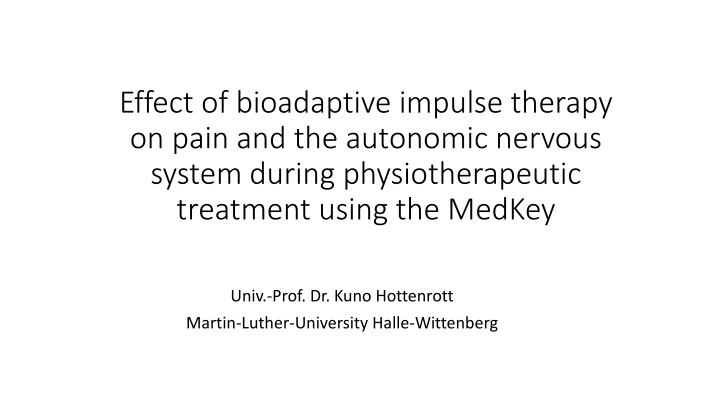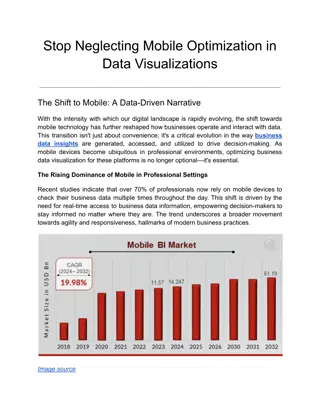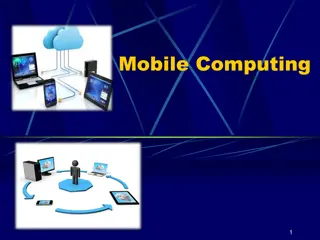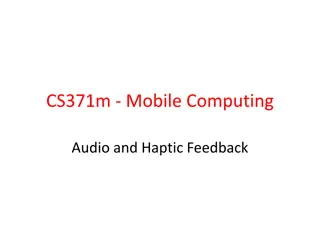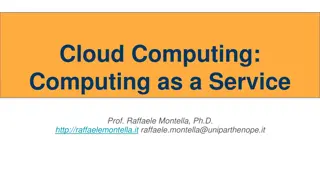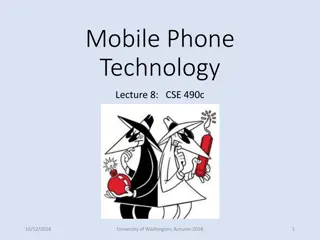Mobile Computing in Modern Era
Mobile computing and its evolution in the modern era, encompassing aspects of mobility, user needs, technological advancements, integration of wireless networks, application scenarios like smart devices, vehicle computing, and more.
Download Presentation

Please find below an Image/Link to download the presentation.
The content on the website is provided AS IS for your information and personal use only. It may not be sold, licensed, or shared on other websites without obtaining consent from the author.If you encounter any issues during the download, it is possible that the publisher has removed the file from their server.
You are allowed to download the files provided on this website for personal or commercial use, subject to the condition that they are used lawfully. All files are the property of their respective owners.
The content on the website is provided AS IS for your information and personal use only. It may not be sold, licensed, or shared on other websites without obtaining consent from the author.
E N D
Presentation Transcript
Effect of bioadaptive impulse therapy on pain and the autonomic nervous system during physiotherapeutic treatment using the MedKey Univ.-Prof. Dr. Kuno Hottenrott Martin-Luther-University Halle-Wittenberg
Scientific background HRV is a biomarker for specific pain-related diseases (Lerma et al., 2011) and a outcome measure for the relief of pain due to therapeutic interventions (Storella et al., 1999; Zhang et al.,2006; Toro-Velasco et al., 2009). Patients with chronic pain show a reduction in HRV and baroreflex sensibility due to changes in efferent sympathetic and parasympathetic cardiac activity, which shift the balance to a sympathetic tone prevalence related to catecholamine release [Nielsen et al., 2014; Broehl et al., 2005]. Higher parasympathetic activity was associated with better self-regulation capacities and, accordingly, a higher pain inhibition capacity (Forte et al., 2022). https://www.ncbi.nlm.nih.gov/pmc/articles/PMC8870705/
Aim of the study Aim of the study is to examine the extent to which treatments with adaptively regulated impulse therapy have an influence on the cardiovascular system, autonomic nervous system, cardiac autonomic regulation and existing pain during physiotherapy treatments.
Method The basis of the examination is the continuous measurement of the heart rate (RR interval) and the determination of heart rate variability. The data was collected while lying down using a special, ECG-accurate chest strap and a specially designed app (HRV-Elite) before, during and after treatment. Patients (m/f/d) with the appropriate indication were selected for this. The treatments took place twice a week for a period of 3 weeks - a total of 6 treatments.
Method A continuous treatment protocol was used for 8 patient over the treatment period. The following data was collected in addition to the RR measurement: VAS pain level 1-10 pre-post per application at rest and during joint movement Dysfunction level 1-10 pre-post per application Gender Age Weight Duration of complaint since onset of complaint Complaint location Duration of treatment per application Medication taken
Data Analysis 20 min Treamtent with Medkey 3 min 3 min
Standardized MedKey Sessions Subject 6 Treatment 1 Treatment 4 Treatment 2 Treatment 5 Treatment 3 Treatment 6
Heart Rate in Supine Position Heart Rate 100 N = 8 90 Heart Rate (1/min) 80 70 60 50 40 before treatment after 48 treamtents Measurement 3 min in supine position
Significant Increase Vagal Activity HRV (RMSSD) 60 N = 8 * 50 40 RMSSD (ms) 30 20 10 p < 0,05 0 before treatment after 48 treatments Measurement 3 min in supine position
Signifcant Decrease Stress Level Stress leveI (Baevesky) 25 N = 8 * 20 Stress Index 15 10 5 p < 0,05 0 before treatment after 48 treatments Measurement 3 min in supine position before treatment
Effect of the Medkey Sessions on pain and stress All treatments in which the patients stated that they were in pain before the treatment were evaluated. Results: 1. For all treatments, the 20 min Medkey Session achieved a reduction in pain for all test subjects by an average of 3 points on the VAS-Skala (0-10). 2. Stress level decrease sig. from 14,8 to 13,2 (p < 0,05)
